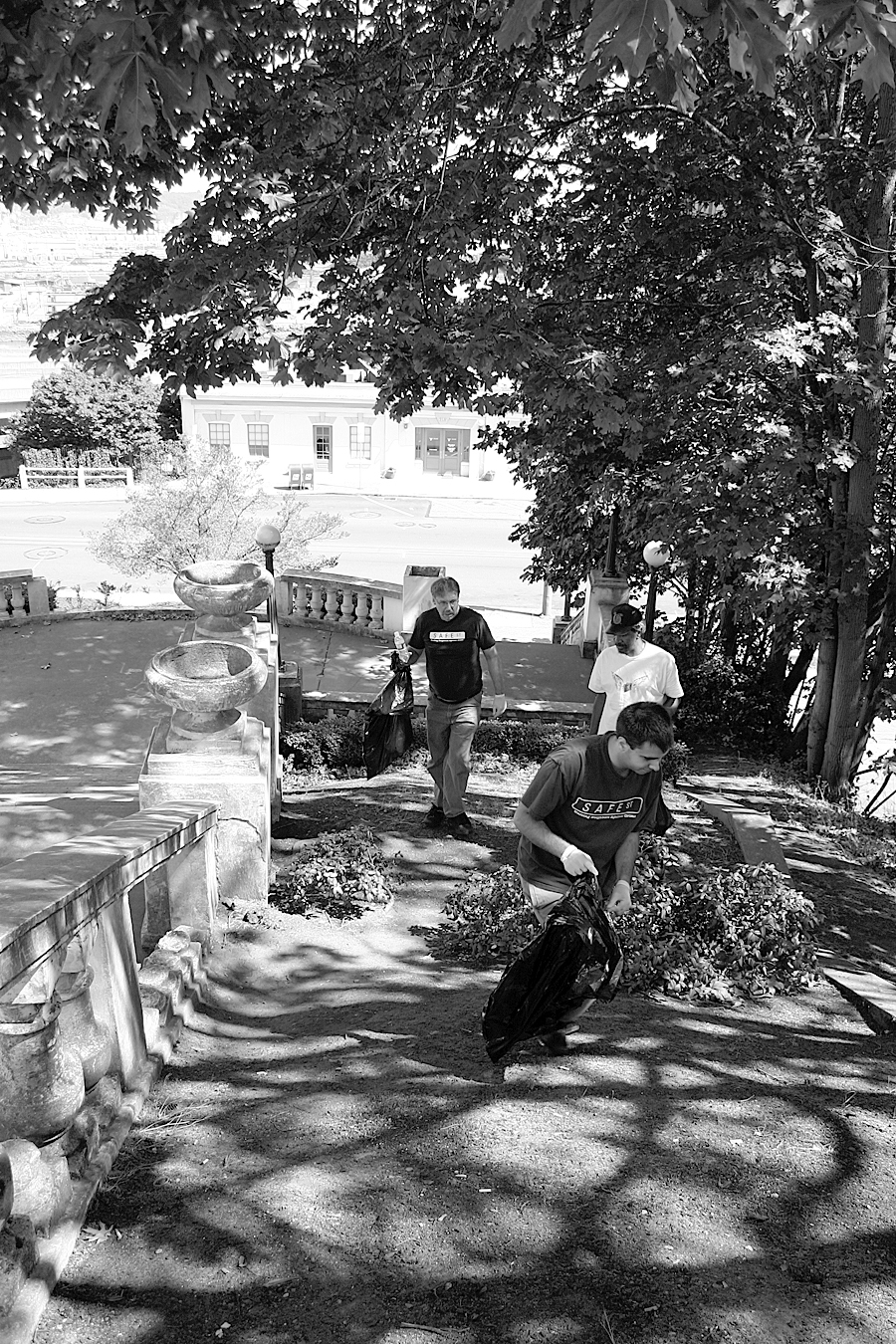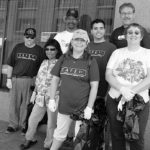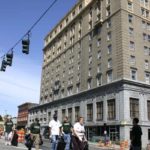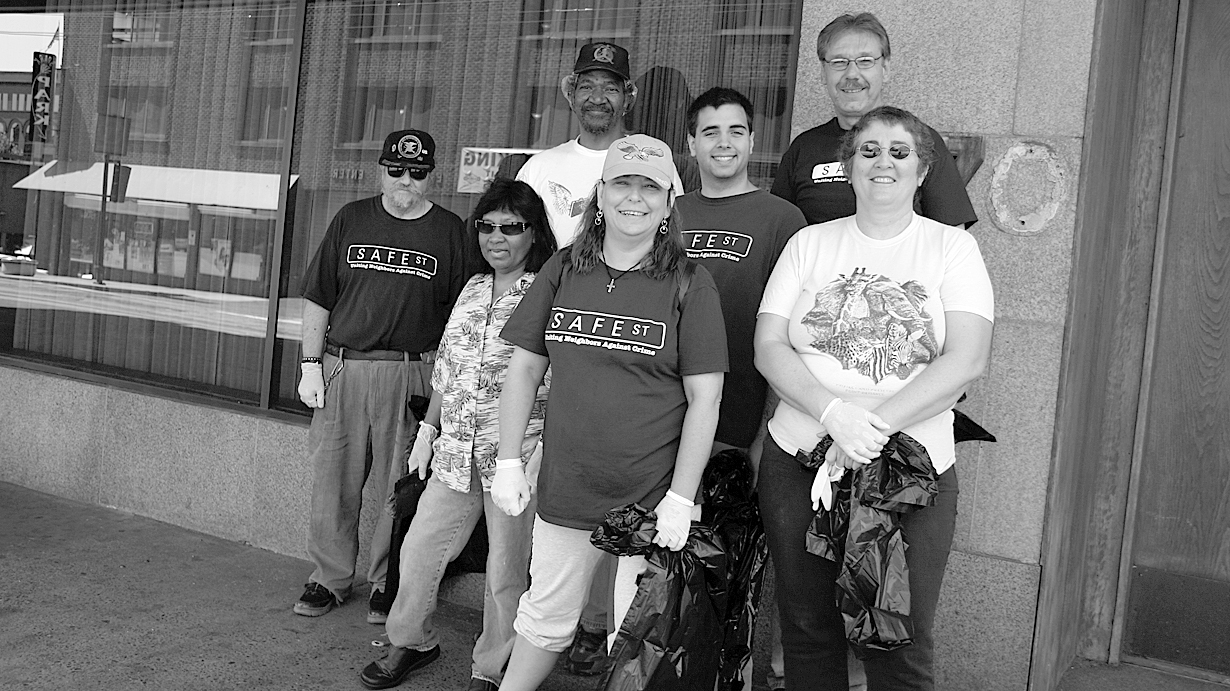It is difficult to change the bad reputation associated with the Winthrop downtown, especially when the reputation sticks to the building like the dirt that has stained the facade’s bricks and tiles for decades.
Nearby merchants have long complained the building is a magnet for criminal activity that stunts the economic hopes of small business owners. The building has consistently topped a list of locations for downtown emergency service calls. This month, four fires were set in the Winthrop by someone Tacoma firefighters and police officers say is a serial arsonist. A Crime Stoppers bulletin was issued last week offering $1,000 for information leading to the arrest of the arsonist.
Add to public safety concerns the issue of what will happen to the building itself. Some people want to see it restored as an historic hotel; others want it shut down; and still others want city leaders to find alternate housing so residents aren’t concentrated in one location. In May, Tacoma Housing Authority (THA) announced that it was asked by Prium (the current building owner who had originally planned to convert the building into a four-star hotel) if it wanted to purchase the building. THA is currently weighing the option.
The Winthrop might have its share of problems, but it is home to approximately 200 low-income residents. In a city that lacks adequate low-income housing (and long waiting lists for that housing), the Winthrop fills a huge hole in a tight housing portfolio.
But for six Winthrop residents and a Safe Streets organizer, improving the building’s reputation is not a lost cause.
On Saturday, residents Lorna Fournier, Glenn Grigsby, John Heffler, Charles Jones, Autumn Wolfe, and Dinah Young met Safe Streets Community Mobilization Specialist Anders Ibsen in the lobby of the 84-year-old, 12-story former historic hotel to pull on gloves, grab plastic garbage bags, enter a raffle for free coffee cards, and head outside to spend part of the afternoon picking up trash.
The group started in front of the building, located at the corner of Ninth and Commerce, and eventually moved north toward the clock tower of Old City Hall, up the Spanish Steps hill climb, and along the former Elks Building. Then they backtracked along Broadway, past the antique shops and toward Theater on the Square.
Over the course of an hour, they picked up almost every kind of garbage you can imagine. Some of it was ubiquitous — greasy fast-food wrappers; faded and brittle newspaper pages; empty bottles of soda. Some of it was a little seedier — Grigsby collected used syringes in an empty water bottle; others picked through bushes to remove crushed beer cans that hung from branches like old Christmas ornaments; used condoms were too disgusting to pick up.
Some merchants and passersby might have seen the group and thought, ‘Good for them.’ For Ibsen and the residents, however, the hope is that people will recognize they are from the Winthrop and they care about the neighborhood.
“[The monthly clean-up is a way to] build relationships between the tenants, as well as meaningful relationships between the Winthrop residents and the downtown area,” says Ibsen. “A lot of people think of drug use and criminality when they think of the Winthrop. They don’t really see the human side. The idea was why don’t we clean the place up that we’re walking around anyway? At the same time build those really essential relationships and prove to people that [the Winthrop residents] are human beings just like you.”
After six months of monthly clean-ups, the group remains small but motivated. Charles Jones, a first-time volunteer, saw a flyer in the lobby advertising the clean-up and decided to join. Dinah Young, also a first-timer, was concerned a permanent eye injury would leave her unable to locate trash. She showed up anyway, met a couple new neighbors, and hauled away a decent amount of garbage.
Did the group solve all of the Winthrop’s problems in one afternoon of picking up garbage?
No.
And no one expected it would.
But in their minds, each piece of garbage collected might have ever-so-slightly changed the perceptions of a building and some of its residents.
– – – – – – – – – – – – – – – – – – – – – –
The Tacoma Daily Index spoke with Safe Streets Community Mobilization Specialist Anders Ibsen about how Safe Streets and Winthrop residents are trying to improve the situation in the building.
TACOMA DAILY INDEX: What is the connection between Safe Streets and the Winthrop?
ANDERS IBSEN: The Winthrop tenants are part of one of our Safe Streets Block Watch groups. We organize neighbors together in groups to make the neighborhood safer, cleaner, and just to get people to know each other and build those meaningful long-term relationships. We’ve had a group with the Winthrop and the Olympus together for about a year-and-a-half now.
INDEX: What does it mean for the Winthrop to be part of a Safe Streets Block Watch?
IBSEN: We have monthly meetings that take place on the fourth Wednesday of each month. On the second Saturday of the month, we have these downtown trash pick-ups.
INDEX: What are the big issues at these monthly community meetings between Safe Streets, Winthrop residents and managers, and Olympus residents?
IBSEN: There are a lot of different issues, but they tend to fall within two categories. One is safety within the building. There’s a big issue with non-residents sneaking in the building. Just recently we’ve had some arsons. There have been false alarms. The Winthrop just got a new building manager — Allied Group took over. They are doing their utmost to change their policies to accommodate the need for safety, taking into account the fact that people are sneaking in and pretending to be residents. So public safety and safety of their building as a whole — that is one of the residents’ biggest concerns. The other category we talk about is their future at the Winthrop. How long they have to stay here? We have broader conversations about Housing and Urban Development (HUD) and Tacoma Housing Authority (THA). Who’s going to take over the building, and where are the residents going to go if they have to move? Ultimately, these clean-ups and broader engagements with the community — just picking up bottles around Antique Row — that’s the Winthrop residents’ way of really talking to people. I really hope it can have a long-term impact of proving to senior decision-makers and the community that these aren’t just throw-away people. They aren’t the problem. The vast majority of people living in the Winthrop, Olympus, and any other THA property are just as law-abiding as any of us.
INDEX: Approximately 200 people live in the Winthrop. As I understand it, packing low-income residents into a high-rise hotel is a model HUD and other affordable housing advocates say doesn’t work anymore. I imagine it can be daunting in terms of management and public safety to have 200 people in a low-income, downtown Tacoma high-rise, correct?
IBSEN: It’s understandably very challenging. What really makes or breaks these groups is how strong the management is on your side. Are they willing to help you put up signs? Are they willing to be a force of support for the group? Are they going stand and help? Are they going to at least let you do your job? That’s really the decisive factor. Whenever you have more people, you’re always going to have more issues to deal with. That’s why we’re examining the idea of floor captains. It’s similar to the idea of a block leader or section leader, something that we usually have when dealing with single-resident buildings or just dealing with apartment units. We’ve never really done high-rises before the Winthrop and the Olympus. So it’s another idea we’re exploring and it certainly has a lot of merit to it. We’ve had different experiences with different people. A common source of frustration with a lot of tenants is that under the older management, there would be a transition, a new team would come in, it would be like the new sheriff was in town, they would kick some of the biggest trouble-makers out, and a couple months later everything would resume. What we’re hoping with Allied Group is that we can look beyond cosmetic changes and public relations moves and look at structural changes that need to be done. The biggest example would be unauthorized entry into the building. If we could help them reform their policies that they actually use on a day-to-day basis to govern the building’s operations, that might have a much more long-lasting effect. They are receptive to us.
INDEX: How has Safe Streets’ been involved with the recent fires set in the Winthrop?
IBSEN: When the arsons and false alarms happened, I got an e-mail the next day. It was an urgent message from their portfolio manager about the need to have a meeting as soon as possible to confront the problem and look at long-lasting ways to stop them. The arsons are very recent. They happened within the past couple weeks. Immediately, I got an e-mail from Audrey Hornbuckle, the City of Tacoma’s Crime Free Rental Housing Coordinator. Audrey and the Allied Group were really adamant that we needed to step up organizing and basically do what we were doing before, times two. We need to have more frequent meetings, at least until we can make those necessary policy changes. We need to establish more of a floor-captain system in the Winthrop itself. One for each floor, especially the problem areas. Just do what we were doing but with an even more structured approach.
INDEX: How effective has Safe Streets been at the Winthrop?
IBSEN: It’s always difficult to say because the Winthrop has always had one of the highest calls for service in the downtown area. The attitude on this is that it’s never a question of just completely removing the need for calls for service. You’re always going to have them to some extent. But it’s a matter of building an infrastructure that lets you rapidly respond to things. For example, if we didn’t have the Safe Streets group right now, I can guarantee you there would be chaos with these arsons and false alarms. Because we’ve had this group in place for a year-and-a-half, we immediately have leaders in the Winthrop who we can fall back on. Leaders who can turn out people to the meetings, advocate for their safety, and tell the people working in building management what the needs of the tenants are. So it’s a form of rapid response and a form of permanent infrastructure that can be put into place whenever it’s needed. If there’s one truism in human nature, there is always a core of leaders. Wherever you have a group, there’s always native leadership. Why people organize is for the simple reason that you can’t rely on one single person to do it. You can’t just have your leaders. You have to have a good sense of teamwork.
– – – – – – – – – – – – – – – – – – – – – –
To read the Tacoma Daily Index‘s complete and comprehensive coverage of the Winthrop Hotel, click on the following links:
- A Building on the Brink: Add nuisance report, falling debris to Winthrop’s woes (Tacoma Daily Index, August 19, 2011)
- A Building on the Brink: A line-item look at Winthrop’s hefty deferred maintenance bill (Tacoma Daily Index, August 10, 2011)
- A Building on the Brink: Property report puts $15.7M price tag on Winthrop Hotel’s deferred maintenance (Tacoma Daily Index, August 9, 2011)
- Leaving The Winthrop (Tacoma Daily Index, August 17, 2010)
- 7-year prison sentence for Winthrop arsonist (Tacoma Daily Index, April 23, 2010)
- Accused Winthrop arsonist pleads guilty (Tacoma Daily Index, February 2, 2010)
- Year In Review: Winthrop Hotel (Tacoma Daily Index, December 29, 2009)
- Living On Edge: Inside the Winthrop arson investigation (Tacoma Daily Index, October 23, 2009)
- Winthrop resident accepts Safe Streets award (Tacoma Daily Index, September 16, 2009)
- Winthrop resident named Safe Streets Superstar (Tacoma Daily Index, September 10, 2009)
- Cleaning up a neighborhood, battling a building’s reputation (Tacoma Daily Index, August 25, 2009)
- Crime Stoppers offers $1,000 reward for Winthrop serial arsonist (Tacoma Daily Index, August 21, 2009)
- Historic hotel or housing? Tough economy shines realistic light on Winthrop development plan(Tacoma Daily Index, August 4, 2009)
- Winthrop history, development ideas equally storied (Tacoma Daily Index, June 4, 2009)
- Inside the Winthrop (Tacoma Daily Index, June 2, 2009)
- THA weighs Winthrop building purchase (Tacoma Daily Index, May 29, 2009)
- One dead in Winthrop Hotel fire (Tacoma Daily Index, March 25, 2008)
- Resolution would sell City-owned property for mixed-income housing (Tacoma Daily Index, October 29, 2007)
- Developer eyes City surplus property for Winthrop Hotel project (Tacoma Daily Index, September 26, 2007)
- Winthrop vote illuminates citys affordable housing concerns (Tacoma Daily Index, March 22, 2006)
- Council resolution on Winthrop rehab expected tonight (Tacoma Daily Index, March 21, 2006)
- Council may vote on whether it supports Winthrop rehabilitation plan (Tacoma Daily Index, March 20, 2006)
- Winthrop repairs mean no evacuations (Tacoma Daily Index, December 19, 2005)
In 2009, the Tacoma Daily Index published a series of interviews with many residents of the Winthrop Hotel. To read the complete series, click on the following links:
- A Voice From the Winthrop: Glenn Grigsby (Tacoma Daily Index, June 16, 2009)
- A Voice From the Winthrop: Otha Adams (Tacoma Daily Index, June 26, 2009)
- A Voice From the Winthrop: Nanette Colby (Tacoma Daily Index, July 15, 2009)
- A Voice From the Winthrop: John Heffler (Tacoma Daily Index, July 30, 2009)
- A Voice From the Winthrop: David Allen (Tacoma Daily Index, August 13, 2009)
- A Voice From the Winthrop: David Miller (Tacoma Daily Index, August 20, 2009)
- A Voice From the Winthrop: Kerry Hudson (Tacoma Daily Index, August 27, 2009)
- A Voice From the Winthrop: Jessica Creso (Tacoma Daily Index, September 1, 2009)
Todd Matthews is editor of the Tacoma Daily Index and recipient of an award for Outstanding Achievement in Media from the Washington State Department of Archaeology and Historic Preservation for his work covering historic preservation in Tacoma and Pierce County. He has earned four awards from the Society of Professional Journalists, including third-place honors for his feature article about the University of Washington’s Innocence Project; first-place honors for his feature article about Seattle’s bike messengers; third-place honors for his feature interview with Prison Legal News founder Paul Wright; and second-place honors for his feature article about whistle-blowers in Washington State. His work has also appeared in All About Jazz, City Arts Tacoma, Earshot Jazz, Homeland Security Today, Jazz Steps, Journal of the San Juans, Lynnwood-Mountlake Terrace Enterprise, Prison Legal News, Rain Taxi, Real Change, Seattle Business Monthly, Seattle magazine, Tablet, Washington CEO, Washington Law & Politics, and Washington Free Press. He is a graduate of the University of Washington and holds a bachelor’s degree in communications. His journalism is collected online at wahmee.com.














